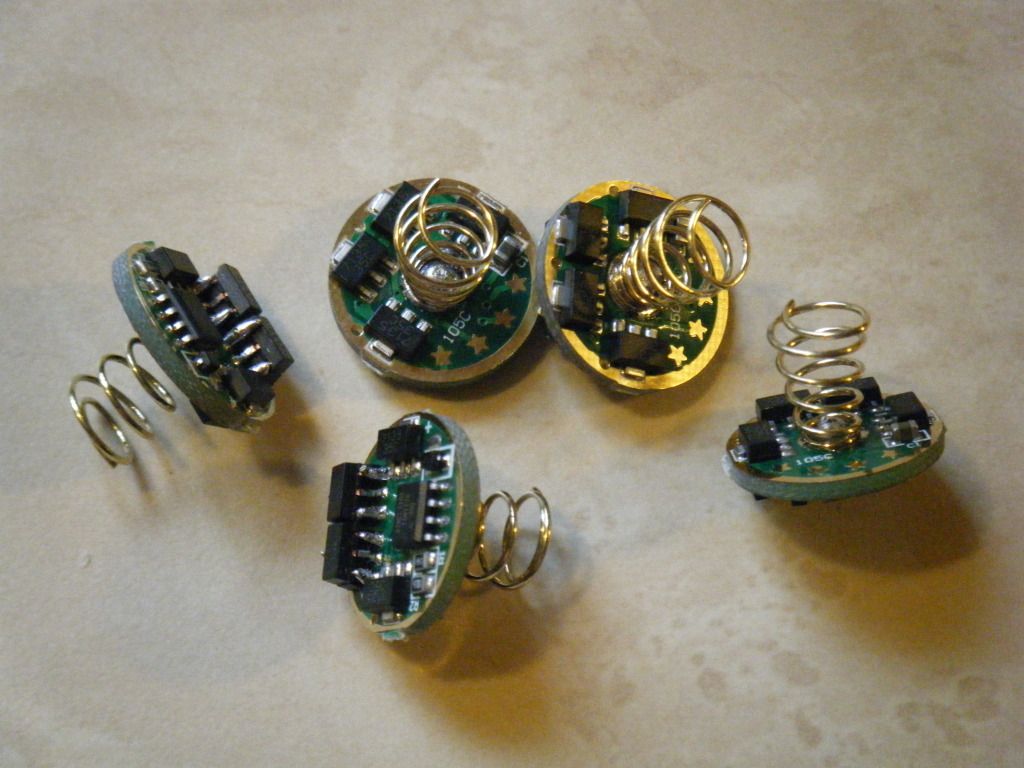Never mind
Not the best picture but just add another 7135 chip by stacking on top of another one. These have two added.

Add another battery? It’s a linear driver - it can’t put out more voltage than it takes in.
Is it even possible for an XM-L to only register 3.03Vf at 2.8A? Maybe the emitter isn’t getting 2.8A?
Excuse me if I am off base. I am kind of a newb.
It is possible. 3.35 is “Typical”, but LEDs vary quite a bit from one to another in regards to Vf. I’ve seen them lower than that, in fact.
When driving an LED, you don’t try to maintain a voltage - you maintain a current. Voltage will take care of itself.
Unfortunately, if you don’t have a way to directly measure current at the tailcap, then there is no way to know if your emitter is a low Vf one that is getting 2.8A or if something is wrong (your battery can’t keep up with 2.8A draw, one or more of the AMC7135 chips is non-functional, etc). Measuring emitter voltage doesn’t tell you anything.
PPtk
Welcome to the club, YoSeKi!


If you measure the current and it’s 2.8A, then everything is fine and the LED gets exactly the voltage it wants. 3.03V s not unplausible for a hot XM-L.
If you want to optimize something, try to reduce contact resistance to the battery.
I have used IMR batteries where voltage sag at higher amp draw was an issue.
I have used IMR batteries where voltage sag at higher amp draw was an issue.
IMR or A123 cells are great when you need high current. 2.8Amps is hardly high-current for most of today’s cells though… With a 2900mAh cell, that’s not even 1C discharge.
Hmm, I don’t quite agree with the answers
I will do some more researches and let you know.
Basically the LED takes the voltage the driver is giving, but the driver doesn’t give the voltage the LED is requesting.
I am using redilast 18650, that are pretty good batteries.IMO the driver is just not fully optimized.
With my previous driver that goes to direct drive in High mode, and gives about 3.5 to 4A to the LED, the LED was giving more lumens, but it is not due to the current, as the max current is about 3A. Above that you usually get mostly heat.
You definitely need to read up on how an LED functions and how OHMS law relates to it. I’m sorry to say, but you don’t understand either of them at all. If your previous driver gave 3.5 or 4 A of current to the LED, then that is what the LED was taking. Period. No other possible scenario. Max suggested current is 3A, that doesn’t mean you couldn’t push 5A through it - it just means you’d be running outside of the specifications.
PPtk
the LED was giving more lumens, but it is not due to the current
It is due to the current.
LEDs do actually get a lot brighter with more current one member here tested one up to 5 amps and it got brighter with more current. Of course that was direct bonded to copper.
That Is not true, while they are less efficient with higher currents if properly heatsinked they will keep getting brighter until at least 5 amps. Iirc Match was able to get one to reach 1450 lumens which is actually more than Cree says they can.
Yeah scaru, but lets stay within realistic values for regular flashlights. :P
So are you suggesting that 3 amps is the best drive current even for something with a copper heatsink?
No. But there is something inbetween 3A and 5A. Talking about the usual hosts like P60, C8.. I'd say for limited use, 3.5A is the limit. For short "bursts", it might even be close to 4A.. but heat sag occurs rather fast. Most budget lights dont even have proper heatsinking so assuming a well built light with copper heatsink is a little unrealistic. :P
@Silicon: What I'm now telling you might be VERY wrong but it could also be more true than I expect it to be.. anyway, LEDs have a fordward voltage (Vf). They wont light up below that. Voltage determines the maximum current, so an XML wont pull 4A at 2.8V.. it might pull 6A at 4V but it doesnt have to. Thats where the AMC chips come in handy. They limit the current and also burn up some of the voltage but I dont really know if that matters..
I think you didn’t understand me, sorry about it.
The current is the issue, of course the LED will take the current it can, but an XM-L (according to the datasheet if I remember) get the max lumens at about 3A (it can go above, the goal is to regulate it at 3A max), 3.35v. The key for the led is not only V or I but V*I.
After 3A the led gives mostly heat, with only a few more lumens, and the current will probably damage the led after a while. So there is no good reasons to go above 3 or 3.5A.
You’re right, I don’t understand you. I don’t understand why you keep questioning the answers provided by people who understand the laws of physics. “Hmm, I don’t quite agree with the answers”
The key for an LED is I (Current) - Voltage is completely irrelevant. That is why, if you read the CREE datasheets, they will give you luminous intensity at a given current without even talking about voltage. An LED is an imperfect device - every single one of them is different, and this is why Vf in the datasheet is given as a “Typical” value and a “MAX” value, and they are pretty significantly different. A “MIN” isn’t even defined in the datasheet, because CREE doesn’t consider it a problem (and they’re right) if the Vf is lower than Typical. The “Goal” as you put it has NOTHING to do with 3.35V. With an LED, you either control current or you control voltage - the other value becomes what it needs to be all by itself. AMC7135s regulate current.
My driver is the 3.04A version with 1 more 7135 I added, so I should get about 3.4A, and it’s not that bright, not as bright as the TN12 for example. The DMM gives me 3.03v at the led, so for me there was an issue somewhere.
If it’s not as bright as your TN12, then any of these is possible:
- Your TN12 is driven to higher than 3.4A (meaning there is nothing wrong with your driver)
- Your TN12 has a much higher BIN Emitter than the one you’re working with (U2 compared to T4, for instance) (meaning there is nothing wrong with your driver)
- Your TN12 has much better heat-sinking than whatever is currently heat-sinking your LED (meaning there is nothing wrong with your driver)
- Your driver is broken and not actually supplying 3.4A
- Your power source (battery?) can not provide 3.4A
- Your power source (battery?) does not provide enough voltage for the LED to operate at 3.4A (measure your battery voltage while it’s running the LED)
Now according to you, it might be a bad 7135 in my driver ? I can’t verify it, so why not.
If you can’t measure current, then you can not verify if a current regulator is working. To see if a current regulator is putting out its intended current, you’ll have to measure that value.
Many people here have the 105C driver, with some 7135 added. Do you consider getting 650 or 700 lumens with your flashlight ?
It depends on the heat-sinking of the LED and the efficiency of the optics. 700 Lumens OTF of an XM-L based flashlight is pretty normal.
I am a nwb in electronic, so yes I have some lacks of knowledge, sorry about it.
Your being a newbie and having a lack of knowledge is no problem - there are lots of us here willing to help. That you continue to ignore the answers provided and replace fact with assumption and ill-knowledge is a bit more frustrating.
PPtk
You’re right, I don’t understand you. I don’t understand why you keep questioning the answers provided by people who understand the laws of physics. “Hmm, I don’t quite agree with the answers”
The key for an LED is I (Current) - Voltage is completely irrelevant. That is why, if you read the CREE datasheets, they will give you luminous intensity at a given current without even talking about voltage. An LED is an imperfect device - every single one of them is different, and this is why Vf in the datasheet is given as a “Typical” value and a “MAX” value, and they are pretty significantly different. A “MIN” isn’t even defined in the datasheet, because CREE doesn’t consider it a problem (and they’re right) if the Vf is lower than Typical. The “Goal” as you put it has NOTHING to do with 3.35V. With an LED, you either control current or you control voltage - the other value becomes what it needs to be all by itself. AMC7135s regulate current.
I have just read some more docs about how do drive a led and I got it now.
Just relax, it is also frustrating for me to get answers like those ![]()
Subject is closed :o
“Never Mind” is the new Original Post? I wouldn’t count on getting a lot of help from the people here with that kind of attitude.
E1320, Dr Jones, willie, Vieplis, scaru, NightCrawl, and I all offered you answers, and you still continued to imply that our answers were wrong and that you needed to increase voltage but not current - which is impossible. If you’re uncomfortable being presented with answers that make sense, then I’m sorry about that.
Good luck with your mod.
PPtk
.
If you want to optimize something, try to reduce contact resistance to the battery.
Dr. Jones (or anyone), could you maybe elaborate? I am getting some intermittent “flickering” (funny sounding word lol) with my SE-1 (Balder) and I pulled tail cap & it seems ok. The head is potted so can”t get at that. Bad tail cap switch? Chip? Any ideas? I need to find the prob before the send back window closes. Appreciate any help.
Keith (who don”t like no flickering)